There are twenty-four James Bond films produced by EON Productions and distributed by United Artists and MGM. The first, Dr. No was released in 1962 and the twenty-fourth installment, Spectre, was released in 2015; making it one of the longest-running film series of all time. Combined, all 24 released Bond films have grossed over $7.0 billion. (Adjusted for 2015 inflation: $16.1 billion.)
There are also two additional James Bond films, Casino Royale (1967) and Never Say Never Again as well as a single TV production of Casino Royale.
History

Fleming, Saltzman, and Broccoli
The films, derived from Ian Fleming's series of James Bond books began production after Fleming's novels failed to take off in the television sphere with a 1954 production of Casino Royale. In 1959, Albert R. Broccoli began pursuing the books for film adaptation and in 1961 his new business partner Harry Saltzman purchased the rights to all of Fleming's novels (except Casino Royale). The two began shopping Dr. No and Thunderball to production studios for funding but were shot down several times until United Artists struck a deal to produce Dr. No for $1.2 million. Broccoli and Saltzman then founded EON Productions to manage the film's production.
Connery

Connery as Bond
Broccoli and Saltzman began a UK-wide search to cast Bond and held a "Find James Bond" contest to encourage auditions. The winner, Peter Anthony, dropped out due to stress. Patrick McGoohan, Richard Johnson, James Mason, Rex Harrison, David Niven, Trevor Howard, and Broccoli's friend Cary Grant were all in contention at one point but Sean Connery won out in the end, having proven himself to the producers in his roles in On the Fiddle and Darby O'Gill and the Little People.
Connery appeared in five Bond films; 1962's Dr. No, 1963's From Russia with Love, 1964's Goldfinger, 1965's Thunderball, and 1967's You Only Live Twice; before announcing that he was leaving the series at the end of his contract. He was burnt out due to the rapid schedule and wanted to branch his career out.
Lazenby
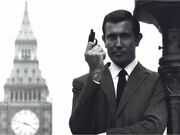
Lazenby as Bond
Broccoli and Saltzman began another search for Bond and decided on Timothy Dalton who turned the role down because he believed he was too young for the role. The producers eventually discovered George Lazenby in an action-themed Fry's Chocolate Cream commercial. His Australian nationality caused something of a stir in the Bond community but his 1969 film On Her Majesty's Secret Service turned out to be a decent critical and commercial success. Lazenby's talent agent urged him to move on from Bond and use his press to launch his acting career. He heeded his advice and dropped his 7-film contract.
Connery, again
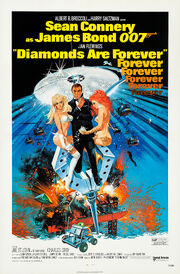
Frustrated with Lazenby's departure, Broccoli and Saltzman wanted to reassure audiences of EON's steadfastness and the franchise's future by delivering another crowd-pleaser. They tried to recreate the magic of Goldfinger by getting director Guy Hamilton and star Sean Connery back together for another United States based Bond film. Connery demanded a $1.25 million paycheck plus 12.5% of all gross profits and an additional $145,000 per week if the film was in theaters for over 18 weeks. His fee was outrageously high for 1971 but producers granted it to him and the 1971 film Diamonds Are Forever was released to thrilled audiences and critics. Connery later used all his proceeds from the film to fund the Scottish International Education Trust, a scholarship for Scottish artists.
Moore
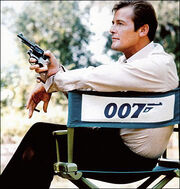
Moore as Bond
Rejuvenated with the success of Diamonds Are Forever, Broccoli and Saltzman began a third hunt to cast James Bond. They were searching for a Bond who would best represent the 1970s — suave and progressive. Jeremy Brett, Michael Billington, and Julian Glover were all considered but Roger Moore landed the spot. His previous TV roles in The Saint and The Persuaders gained him nation-wide attention and respect in the UK. Moore made seven films, making him the longest-tenured Bond in EON productions. He first appeared in 1973's Live and Let Die followed by 1974's The Man with the Golden Gun, the final film to be co-produced by Harry Saltzman who left due to immense debt causing him to lose his EON shares. Moore's popularity grew with 1977's The Spy Who Loved Me, the first Bond film crafted from entirely original material, as Fleming was dissatisfied with his novel of the same name. Moore also proved he could take Bond beyond any imaginable limits in 1979's Moonraker and 1981's For Your Eyes Only after which he decided to leave the role.
Michael G. Wilson joined the production team at this time, and a search began for a new Bond. The producers eventually settled on American James Brolin and he was signed. Brolin even went so far as to buy a home in England. But the announcement that the non-EON production Never Say Never Again would star Sean Connery as Bond made the producers unwilling to launch a new Bond opposite Connery. Consequently, they re-signed Moore for two additional films, 1983's Octopussy and 1985's A View to a Kill, after which Moore finally hung up his holster at age 57.
Dalton
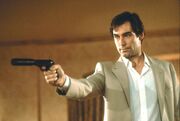
Dalton as Bond
Dalton was first approached to play Bond in 1969 and later in 1981 but was finally free from other obligations for 1987's The Living Daylights and felt he was finally ready to helm the role of 007. (Pierce Brosnan was briefly considered but was busy with Remington Steele.) Like Connery and Moore before, Dalton was a Bond for his era. More hard-edged than his predecessors, it is said that Dalton's Bond most accurately reflects Fleming's Bond.
Dalton returned in 1989's Licence to Kill which was fraught with complications. The film was the first to stray extremely far from Fleming's source material, to save money the film was shot in Mexico rather than Pinewood Studios, and the title was changed from License Revoked close to the release date. Its performance was mediocre at the box office but the real problems came with the sale of MGM and United Artists to Pathé Communications. EON's parent company Danjaq sued Pathé for television distribution rights, freezing all Bond productions until 1995. In the run-up to what would have been his third Bond film, The Property of A Lady, Dalton stepped away from the role in 1994 when he chose not to renew his contract.
Brosnan
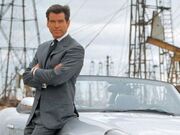
Brosnan as Bond
After a seven year hiatus many wondered if Bond was still relevant to the world, namely since many of his foes were from the now-dissolved Soviet Union. At age 86 and fed up with the previous years of legal disputes, Albert R. Broccoli stepped away from the Bond series and was replaced by his daughter Barbara Broccoli.
Without a star for Bond, Barbara Broccoli and Michael G. Wilson decided to rejuvenate the franchise. They had previously met Pierce Brosnan on set of For Your Eyes Only and his schedule was now free for him to don the tuxedo as Bond. Brosnan portrayed a Bond for the 1990s — technologically and culturally savvy. The 1995 film GoldenEye also brought on Judi Dench as M and was met with the highest attendance rates since Moore's films. Brosnan's success continued with 1997's Tomorrow Never Dies, 1999's The World Is Not Enough and 2002's Die Another Day. Brosnan, now 50 years old, decided to leave the series on a high note in 2004.
Craig
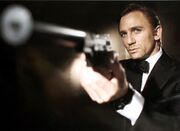
Producers Barbara Broccoli and Michael G. Wilson once again had a blank slate and had an opportunity to reinvent the Bond franchise. The success of the gritty and realistic films The Bourne Identity and Batman Begins, and the recently acquired rights to Fleming's first novel Casino Royale led the producers to entirely reboot the series with an origin story that was focused on Bond's motivations rather than gadgets, guns, and girls. In October 2005 Daniel Craig was announced as the new Bond. Die-hard fans complained of his blonde hair but his strong performance won their support.
2006's Casino Royale was one of the franchise's highest grossing entries and successfully launched Craig's burgeoning career. 2008's Quantum of Solace was met with less acclaim but still performed strongly at the box office. The twenty-third Bond film was in preproduction when MGM declared bankruptcy in 2010. The film was postponed indefinitely (although Broccoli, Wilson, and Craig worked unofficially) until January 2011. The film, Skyfall was released in October 2012 — fifty years after Dr. No first hit the silver screen in 1962.
Craig has signed on to appeared in two more Bond films, 2015's Spectre and its successor Bond 25.
List of films
List of films in the official EON film series:
| Title | Year | Actor | Director | |
|---|---|---|---|---|

|
Dr. No | 1962 | Sean Connery | Terence Young |

|
From Russia with Love | 1963 | ||

|
Goldfinger | 1964 | Guy Hamilton | |

|
Thunderball | 1965 | Terence Young | |

|
You Only Live Twice | 1967 | Lewis Gilbert | |

|
On Her Majesty's Secret Service | 1969 | George Lazenby | Peter R. Hunt |

|
Diamonds Are Forever | 1971 | Sean Connery | Guy Hamilton |

|
Live and Let Die | 1973 | Roger Moore | |

|
The Man with the Golden Gun | 1974 | ||

|
The Spy Who Loved Me | 1977 | Lewis Gilbert | |

|
Moonraker | 1979 | ||

|
For Your Eyes Only | 1981 | John Glen | |

|
Octopussy | 1983 | ||

|
A View to a Kill | 1985 | ||

|
The Living Daylights | 1987 | Timothy Dalton | |

|
Licence to Kill | 1989 | ||

|
GoldenEye | 1995 | Pierce Brosnan | Martin Campbell |

|
Tomorrow Never Dies | 1997 | Roger Spottiswoode | |

|
The World Is Not Enough | 1999 | Michael Apted | |

|
Die Another Day | 2002 | Lee Tamahori | |

|
Casino Royale | 2006 | Daniel Craig | Martin Campbell |

|
Quantum of Solace | 2008 | Marc Forster | |

|
Skyfall | 2012 | Sam Mendes | |

|
Spectre | 2015 |
Film grosses
Grosses of official and unofficial films (adjusted to 2015 Inflation):
| Film # | Bond Film | Year | Bond Actor | Adjusted Grosses | Rank |
|---|---|---|---|---|---|
| 1 | Dr. No | 1962 | Sean Connery | $471,966,090 | 19 |
| 2 | From Russia with Love | 1963 | $618,429,676 | 12 | |
| 3 | Goldfinger | 1964 | $966,993,645 | 3 | |
| 4 | Thunderball | 1965 | $1,079,374,580 | 2 | |
| 5 | You Only Live Twice | 1967 | $737,782,781 | 7 | |
| 6 | Casino Royale (1967) | 1967 | David Niven | $304,935,981 | 26 |
| 7 | On Her Majesty's Secret Service | 1969 | George Lazenby | $440,323,305 | 21 |
| 8 | Diamonds are Forever | 1971 | Sean Connery | $708,368,997 | 10 |
| 9 | Live and Let Die | 1973 | Roger Moore | $716,622,013 | 9 |
| 10 | The Man With the Golden Gun | 1974 | $526,039,543 | 16 | |
| 11 | The Spy Who Loved Me | 1977 | $772,233,320 | 5 | |
| 12 | Moonraker | 1979 | $764,250,064 | 6 | |
| 13 | For Your Eyes Only | 1981 | $560,690,626 | 15 | |
| 14 | Octopussy | 1983 | $451,115,101 | 20 | |
| 15 | Never Say Never Again | 1983 | Sean Connery | $392,914,623 | 23 |
| 16 | A View to a Kill | 1985 | Roger Moore | $347,628,210 | 24 |
| 17 | The Living Daylights | 1987 | Timothy Dalton | $413,286,319 | 22 |
| 18 | License to Kill | 1989 | $312,943,317 | 25 | |
| 19 | Goldeneye | 1995 | Pierce Brosnan | $562,838,339 | 14 |
| 20 | Tomorrow Never Dies | 1997 | $502,901,596 | 18 | |
| 21 | The World is Not Enough | 1999 | $525,782,901 | 17 | |
| 22 | Die Another Day | 2002 | $577,815,185 | 13 | |
| 23 | Casino Royale (2006) | 2006 | Daniel Craig | $726,491,897 | 8 |
| 24 | Quantum of Solace | 2008 | $669,396,117 | 11 | |
| 25 | Skyfall | 2012 | $1,166,741,287 | 1 | |
| 26 | Spectre | 2015 | $880,199,082 | 4 | |
| Total | $16,116,015,522 | ||||
Gallery
External Links
- For more information, check out James Bond on the Die Hard Scenario wikia.

